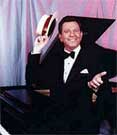|
|
||||
|
by Diana Saenger  Although Singin’ in the Rain never won major awards for the film itself, this nostalgic musical has stood the test of time and is as notable today as it was in 1952. The Broadway show is still touring, and the 50th anniversary 2-disc DVD release from Warner Home Entertainment will entertain generations yet to come. An international and national favorite topping many "best of" lists, Singin’ in the Rain starred dancing sensation Gene Kelly, pratfall genius/hoofer Donald O’Connor, and newcomer Debbie Reynolds. The film uses dance sequences to tell a story about making movies and transitioning from silent films to talkies. The focus is on a ditzy actress (Jean Hagen) who has a voice so squeaky, it destroys her chances to continue her career. Unless – someone takes her place off camera as her voice (Reynolds). Donald O’Connor, who recently turned 77, is enthusiastic about the new release and remembers the details of making the film as if it were yesterday. "It’s a great movie, and it should be kept alive forever if possible," he said in our interview. O’Connor was not the first choice for the role of Cosmo. Oscar Levant intended to play Gene Kelly’s sidekick, but when Kelly and O’Connor got together to sing and dance, it was magic made for the movies. The two talents worked together as twins. Kelly and O’Connor’s superb comedic timing and dance productions were amazing, every movement in unison. "When we started to talk about what we would do choreography-wise, he (Kelly) said ‘We’ll go on the stage, do about eight bars, and then we’ll jump over to the left,’" O’Connor explained. "Later, I thought which way does he turn? I only turn to the left and everybody turns to the right. The next day Gene asked me, ‘Which way do you turn?’ I answered, ‘To the left.’ He said, ‘Thank God, so do I.’ Both of our strong sides were the same side, and that’s why we looked so good doing those numbers." O’Connor’s most standout number, probably of all time, is the "Make Em Laugh," sequence. How did that come about? "Gene said, ‘Why don’t you take the girls,’ (Jeanie Coin, and Carole Haney, his assistant choreographers) and see what you can come up with?’ So I got a pianist, took the girls into a rehearsal hall, and I began to sing and did a pratfall. Whatever they laughed at the most, that’s what we did on the screen. I had to do it in one day because I was doing the pratfalls on cement, and my body, knees, ankles, and toes started to hurt. We saw right then we had to get the number done in one day, and we did it." In filmmaking, one take often isn’t enough as O’Connor found out two days later. "The next day I go on the set and discover the cinematographer or one of his assistants didn’t see that the aperture on the camera wasn’t correct when we filmed. That whole number was fogged out so I had to do it all over again." O’Connor appreciated that Kelly allowed him such a big production number as "Make Em Laugh." "That’s the true character of this man. He was not afraid of competition. If you could be better than he was, he loved it because that was his persona." One of the funniest memories O’Connor has of the actual filming of Singin’ In The Rain was when Kelly sang the title song out in the rain. "They were on the back lot and he’s singing, so happy and he looks great, and the rain is coming down, and just at a perfect timing each droplet seems to have its own beat. All of a sudden somebody takes a close look at Gene and his clothes are actually shrinking. No one took into account that the tweed material shrinks. About every 30 minutes, they’d have to make another suit for him. You’d be talking to him between shots, and you’d actually see the material start to rise in his pants and his cuffs. It was really funny. Gene was a dignified man, and particularly in his work. When all of this started to happen beyond his control, it got to him, too. He was hysterical. That is about the funniest occurrence I’ve ever seen in anything." O’Connor has fond memories about his other co-stars, Jean Hagen, Debbie Reynolds and Cyd Charisse. And everyone always wants to know – any romance on the set? "We didn’t have time to be in love," said O’Connor. "We were too darn busy trying to remember the dance routines. We’d go right from one number … then we would immediately jump to another one. We really didn’t have time to fool around. Although I’m sure we all did our share of flirting, with whom and when I can’t tell you, but I’m quite sure we did." Hagen and Reynolds were under contract at MGM, the studio that made Singin’ In The Rain. "Jean Hagen was a wonderful dramatic actress but in Singin’ In The Rain she didn’t play a ditzy blonde – she was so talented – she was a ditzy blonde. "Debbie Reynolds was a remarkable girl. She is so giving and wanting that you want to take her into your arms. At the same time, she has enough rejection in her to make her very interesting. When they said she’d never taken dance lessons before, it was difficult to believe, but true. She had to learn all that stuff with Gene, and I was pressing because there was a time span that we had to put everything together. The way she picked up on everything and worked strong, she’s a consummate pro. Debbie was just perfect for that part." Reynolds was chosen for the role of Kathy Selden over other MGM contract stars, Jane Powell, Judy Garland and Kathryn Grayson. Author and film historian Rudy Behlmer said about Reynolds, "She was very young, and she thought she knew a lot more than she did. But she is certainly talented." Stanley Donen, co-director of Singin’ In The Rain (with Kelly), received a lifetime achievement award from the Academy of Motion Picture Arts and Sciences. What memories does O’Connor have of Donen, himself a wonderful dancer and performer? "He is a real ham," said O’Connor. It was difficult for him to keep back, but he was wonderful. Never at anytime was there any friction on us to work harder or to stop trying to be silly kids. His temperament and foresight were wonderful." O’Connor won the Best Motion Picture Actor in a Musical/Comedy Golden Globe award in 1953 for Singin’ In The Rain, and screenwriters Betty Comden and Adolph Green picked up a Golden Globe for the film. Filmmaker Baz Luhrmann (Moulin Rouge) thinks Singin’ In The Rain is a notable film. "In a musical you use heightened cinema to tell the story," he said. "Singin’ In The Rain uses song and dance as a device that tells us about the movies. And it winks at you all the way through." O’Connor went on to have a very successful Hollywood career, starring in more than 70 films –including the Francis, The Talking Mule movies – numerous TV shows and working as an actor, dancer, director and producer. He married twice and had four children; Donna Gwen O'Connor (1945), Alicia O'Connor (1957), Donald Frederick O'Connor (1960), and Kevin O'Connor (1961). In 1999 O’Connor was hospitalized with pneumonia. "I was very ill, and it took me quite a few months to recuperate. The name of what I had always eludes me, but it was a fever. It just wouldn’t go away, and I kept withering away until finally they got the correct combination of antibiotics, and I slowly started to get well. It took nine months for me to get back on my feet again." Part of O’Connor’s resolve to get well and dance again is inbred. Born in 1925 in Chicago, O’Connor grew up in a vaudeville family that worked for the circus. He made his film debut at age 12 with his siblings in Melody for Two. "As soon as I was born I went into the act. The more kids you had in the act, the more money you got – $25 a head for each kid. You dance and sing a little bit and work up to acrobatics. The family taught me how to do hand balancing. A car in Hartford, Connecticut backstage of a theater hit my sister and me, and she was killed. From that time on the family was overly protective with me, so I never got to learn those great tumbling tricks like my brother Billy or my brother Jack could do. I did pick things up as I went along. When I got the idea for Singin in the Rain of doing a back somersault off one roll, a back somersault off the other roll, and go through the third roll, I brought my brother Jack in to teach me how to do all those tricks." Dancing has not only been a joy for O’Connor’s fans to watch, but an important component of his life journey. "I’m the guy who danced through life. It seems that no matter what I do, if I did MacBeth, they’d want me to do eight bars of ‘Tea for Two’ just because it pleases. It’s the kind of dancing I do – jumping around and having a good time. It’s happy, gay, and pleasant. Dancing is so wonderful. Once they start the music, your whole day, if it’s been rotten, seems to melt away. You get carried away in the tune that you’re moving to. It’s a marvelous catharsis … to be able to get on top and tap dance."
|
||
|
© 2025 - ReelTalk Movie Reviews Website designed by Dot Pitch Studios, LLC |




